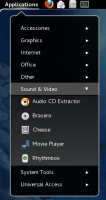Traditional desktop elements and new applications for GNOME 3

![]() The Frippery Applications Menu GNOME Shell extension
The Frippery Applications Menu GNOME Shell extension
Source: Gnome Shell Extensions
With fallback mode due to be scrapped in the forthcoming GNOME 3.8 release, the development team wants to allow users to easily recreate the classic desktop using an included set of extensions. The existing fallback mode, which is used on systems without 3D acceleration, provides a GNOME 2-like interface with a task bar and application menu.
Users who wish to use these elements in the GNOME Shell – the standard GNOME 3 interface – can add them by means of additional GNOME Shell extensions. Whenever a new version of GNOME is released, however, there is always a short lag while extensions are ported to the new version. In addition, for many functions several extensions offer similar capabilities.
In future, GNOME developers are therefore planning to include selected GNOME Shell extensions in the standard desktop. According to developer Matthias Clasen, this will enable GNOME 3 to provide users with classic desktop elements such as the task bar, application menu and minimise buttons on request. Although the developers hope that most users will, once they get used to it, find GNOME 3's new approach comfortable and useful, they have no wish to leave fans of the traditional interface out in the cold.
The GNOME team also wants to develop applications which present various user content – documents, photos, music, videos and downloads – directly in GNOME Shell. Allan Day of the GNOME Design Team has posted a blog entry entitled "The Next Step" which summarises the current state of their deliberations. As well as basic considerations of functionality and app design, it also includes various app mockups. Further details can be found on the GNOME wiki.
The objective of these new applications is to improve access to content and to make it easier to manage. They are not, however, intended to replace the default file manager. The requirements list for the content applications includes a high-performance search function, cloud integration via GNOME Online Accounts, content type-specific presentation, tagging and the integration of content search into the activities overview. For Ubuntu users, much of this may sound familiar. The concept is similar to the Lenses in Ubuntu's Unity desktop.
(crve)



![Kernel Log: Coming in 3.10 (Part 3) [--] Infrastructure](/imgs/43/1/0/4/2/6/7/2/comingin310_4_kicker-4977194bfb0de0d7.png)

![Kernel Log: Coming in 3.10 (Part 3) [--] Infrastructure](/imgs/43/1/0/4/2/3/2/3/comingin310_3_kicker-151cd7b9e9660f05.png)
















